|
Getting your Trinity Audio player ready...
|
As a marketing professional, you know that there are a multitude of channels available to promote your products or services. Besides the traditional methods, you’ve got modern channels like SEO, social media, display ads, and search engine advertising. But email marketing is truly stands out.
Learn everything you want to know about email marketing. We’ll start from the basics and lead you step by step through the process of creating email campaigns that pack a punch. Let’s start with email marketing definition and some history.
What Is Email Marketing?
Email marketing is the act of sending a commercial messages, typically to a group of people, using email. Email marketing meaning refers to the strategic use of email campaigns to promote products, services, or brand messaging to a targeted audience, with the goal of building relationships, driving engagement, and ultimately achieving marketing objectives. It’s the practice of using email to talk to your leads, prospects, and customers. It’s a friendly way of letting them know about important stuff and building a strong connection.
You can use email marketing for various things, like finding new customers, selling your products or services, helping new customers get started, keeping customers interested, and building brand loyalty.
In addition, it is a great way to tell your customers about new products or services, discounts, special deals, or any big news about your business.
You can think of email marketing as your online assistant that sends messages right to your customers’ email inboxes. While it’s like having a chat with them through email, the cool part is that it can make you money!

The Evolution of Email Marketing
Email marketing has a rich history dating back to the early days of the internet when marketers recognized its potential. It began with basic, unsolicited emails, often referred to as “spam.”
You may be surprised to know that email marketing first started in 1978, and the first email message actually resulted in a staggering $13 million in sales. That would translate to $78.8 million today when we account for inflation. Yes, that’s right!
Back in 1978, a guy named Gary Thuerk sent a special email to 400 people. His goal was to increase his company’s computer sales. Surprisingly, this email led to $13 million in sales. But here’s the twist: This email wasn’t just famous for its success; it’s also known as the very first spam message ever sent.
So, in a way, Gary Thuerk’s email not only made a lot of money but also kicked off the era of annoying spam emails we all know today. Quite the double-edged sword, right?
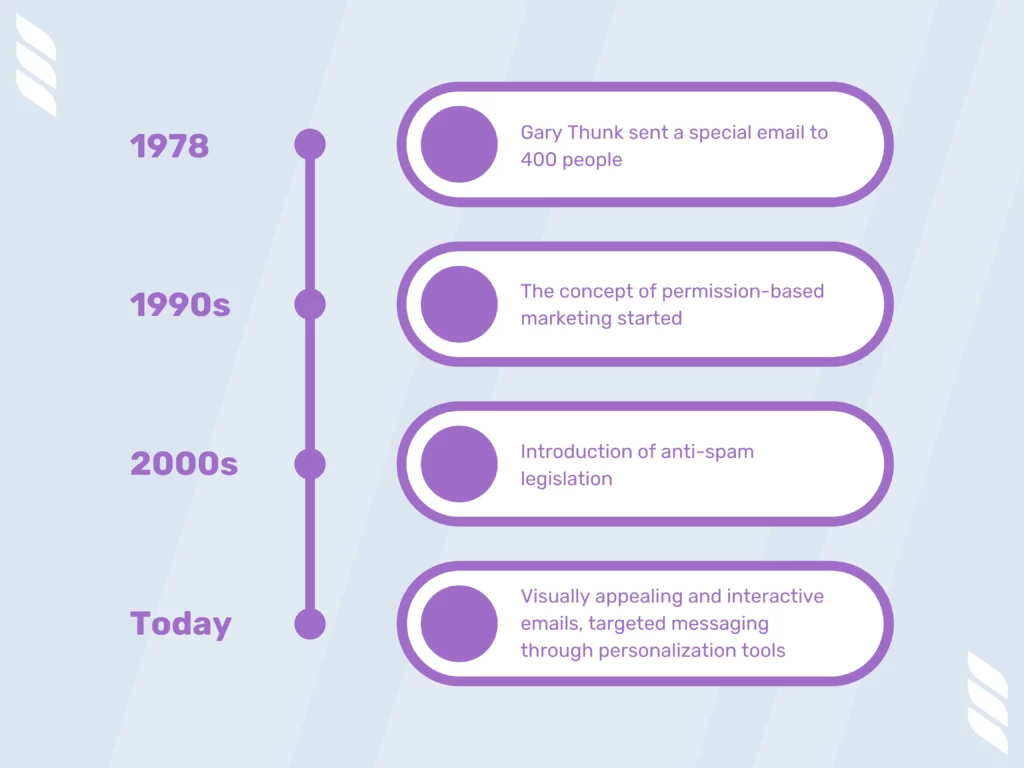

However, the concept of permission-based marketing started in the 1990s, emphasizing the importance of obtaining consent from recipients before sending marketing emails. This shift led to the development of more strategic approaches to email marketing.
The early 2000s saw the introduction of anti-spam legislation, further encouraging responsible email marketing practices. Over time, technological advancements enabled visually appealing and interactive emails, while automation and personalization tools allowed for more targeted messaging.
Read also: How Automated Emails Solve Problems
Mobile device accessibility cemented email marketing as a crucial tool for businesses. Today, it remains a cost-effective and efficient means of engaging and nurturing audiences, driving sales, and fostering customer loyalty.
That was definitely an interesting history of email marketing.
Now, let’s dive in and make email marketing simple and fun to understand. We’ll show you how it can help your business grow, find new customers, and retain your existing customers.
How Does Email Marketing Work?
Wondering how email marketing could work for your business?
Imagine you have a list of subscribers; these are your most valuable connections. You craft emails tailored to their needs, interests, and behaviors. Then, you hit send, and your message lands directly in their inbox. They open it, read it, and hopefully, take action – be it making a purchase, signing up for an event, or sharing your content.
That’s a simple explanation of how email marketing works. However, it requires proper planning and execution to beat the competition and deliver your desired results. Let’s dive deep into the steps of how email marketing actually works.
Step 1: Build Your Email List
Your email list is the lifeblood of your email marketing efforts, and it all begins with the process of email list building. Think of it as assembling a group of eager listeners who want to hear what you say.
First, ensure your sign-up process is a breeze – nobody likes a complicated form. It is a good idea to feature sign-up forms at prominent places on your website, social media, and even at your physical store if you have one. Offer incentives, like exclusive content or discounts, to entice visitors to subscribe. Learn how to get an email list for marketing.
Step 2: Craft Engaging Emails
Once your email list is ready, it’s time to create your emails. Think of your emails as invitations to a conversation, not one-sided sales pitches.
- Start with an attention-grabbing subject line that piques curiosity without resorting to clickbait.
- Keep your content concise, engaging, and focused on addressing your subscribers’ needs, desires, or pain points.
- Use visuals wisely to complement your message, and always ensure mobile responsiveness for readers on the go.
- Personalize your emails by addressing subscribers by name and segmenting your list for more tailored content.
- Include a clear call-to-action that guides your readers toward the desired outcome, whether it’s making a purchase, downloading a resource, or simply clicking a link.
Step 3: Send at the Right Time
Timing is everything, even in the email world. You actually inch closer to success when you send emails when your subscribers are active and most likely to check their inbox.
It might be in the morning, during lunch, or in the evening – you should experiment to find the sweet spot. The goal is ensuring your emails land right when they’re ready to engage with your content.
Step 4: Track and Improve
After sending your email, it’s time to see how your audience reacts. This means you must keep an eye on important numbers like open rates, click-through rates, and conversion rates. This data will help you see what’s working and what needs a little boost. Don’t be afraid to tweak your emails based on what you learn.
Step 5: Build Relationships
Remember, email marketing isn’t just about selling stuff or a one-off transaction. It’s about making friends. Well, kind of! You want to build relationships with your subscribers. So send them stuff they find valuable, like tips that can make their lives easier, stories, or news related to your business. Make sure to keep it consistent so they remember you and look forward to hearing from you. Follow them in social media and share useful eye-catching posts. Learn how email marketing and social media work together.
Step 6: Automate Your Email Campaigns
As your email list grows, things might get overwhelming if you try to do everything manually, so try email automation. That’s where email marketing tools come to the rescue. Dripify sales automation software can help you schedule emails, segment your list, and even personalize messages. It’s like having a helpful party planner who takes care of all the details.
There you have it: the basics to get started with email marketing. Go ahead, try it, and watch your business thrive with the power of email marketing!
Check out our comprehensive article on the best email engagement strategies.
Want to explore the pros and cons of email marketing before getting started? Keep reading.


Advantages of Email Marketing
It’s no wonder that email marketing continues to be a powerful tool in the digital marketer’s arsenal, offering a multitude of advantages that can significantly impact your marketing efforts.
Let’s dive deeper into these benefits:
- Direct Communication: Email is like a direct line to your audience’s heart. It lands in their inbox, a personal space they check regularly. This fosters a sense of connection and immediacy, allowing you to engage with your subscribers on a personal level.
- Targeted Campaigns: Email marketing enables you to divide your audience into segments based on demographics, behaviors, preferences, and more. This segmentation allows you to send highly relevant content to specific groups, increasing the chances of engagement and conversion.
- Cost-Effective: Email marketing is remarkably cost-effective, unlike old-school channels like print or TV ads. You don’t need a hefty budget to reach a substantial audience. Plus, the return on investment (ROI) is often impressive, making it a smart choice for businesses of all sizes.
- Measurable Results: The beauty of email marketing lies in its measurability. Thankfully, modern email marketing platforms allow you to track crucial metrics like open rates, click-through rates, conversion rates, and more. This data-driven approach helps you to continually tweak and improve your email campaigns for optimum results.
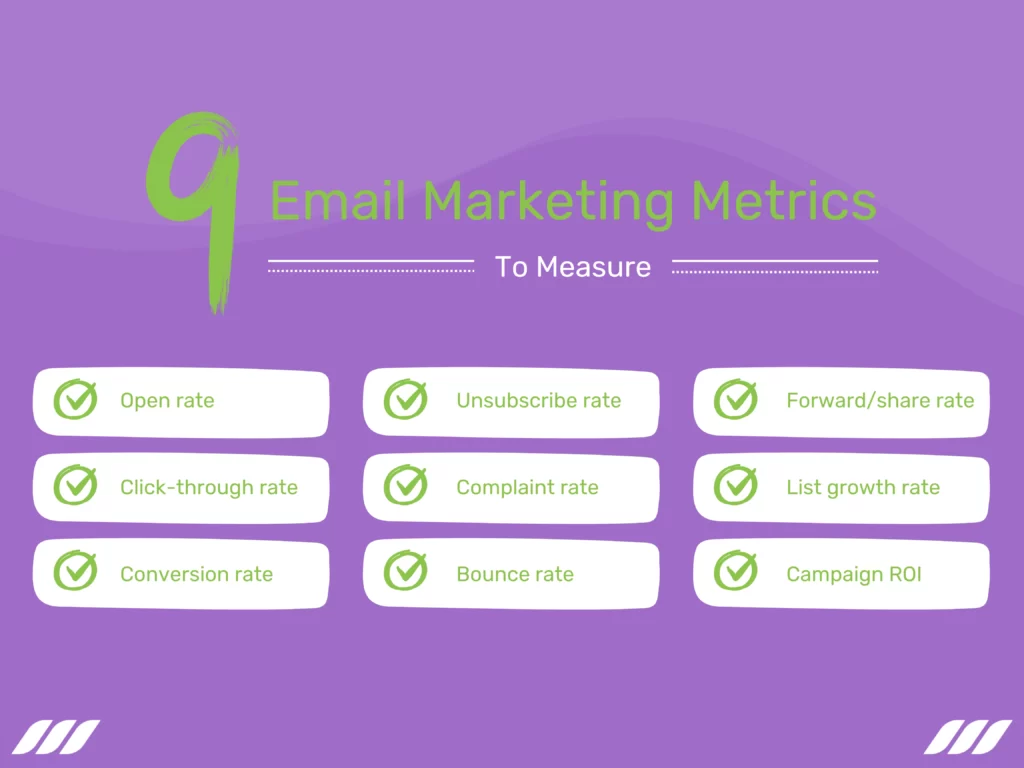

- Automation: Time is a valuable resource, and email marketing offers a lifeline with automation. Automation tools let you create workflows that send emails based on triggers and schedules. Whether it’s welcoming new subscribers, nurturing leads, or re-engaging dormant customers, automation ensures your messages reach the right people at the right time.
- Global Reach: Email knows no borders. With email marketing, you can connect with an audience beyond geographical boundaries. This makes it an excellent choice for businesses with a global presence or aspirations to expand their reach.
- Versatile Content: Email marketing accommodates various types of content. Whether you want to send newsletters, promotional offers, educational content, event invitations, or product updates, email provides the canvas for versatile and engaging communication.
- Brand Consistency: Your emails serve as a direct extension of your brand. You have complete control over the design, tone, and messaging, ensuring consistency across all touchpoints. The result is a reinforcement of your brand identity and fosters trust among your subscribers.
- Data Insights: Every interaction your subscribers have with your emails generates valuable data. This gives you insights into your audience’s behavior and preferences. You can use this knowledge to refine your marketing strategies and deliver content that resonates with your audience.
- Mobile Optimization: As mobile devices become the primary means of accessing emails, email marketing platforms have adapted. Most modern email templates are mobile-responsive, ensuring your messages look great and function seamlessly on smartphones and tablets.
- Personalization: The best thing about email marketing is the ability to personalize your messages. You can address subscribers by their first name, make new product recommendations based on their purchase history, and tailor content to their interests. This personal touch creates a stronger bond between your brand and your audience.
Disadvantages of Email Marketing
While email marketing has numerous advantages, it’s essential to acknowledge the potential pitfalls and disadvantages that come with this powerful tool.
Here’s a closer look at the common email marketing challenges and some quick tips to help you avoid or mitigate them:
- Spam Concerns: Spam is the bane of email marketers. Sending unwanted or irrelevant emails can land your messages in the dreaded spam folder, harming your sender reputation. To avoid this, ensure that your subscribers have opted in to receive emails from you, regularly clean your list to remove inactive or invalid addresses, and follow email marketing regulations like the CAN-SPAM Act. It is a good idea to use a double opt-in process to confirm subscribers’ consent.
Explore our guide on how to avoid spam filters.
- Content Creation Challenges: Creating engaging and valuable emails can be time-consuming. What’s more, finding the right balance between informative and concise content can be challenging. Be sure to schedule your email content ahead of time using a content calendar. This practice will keep your communication consistent and ensure you consistently cover relevant topics. Also, consider repurposing existing content to save time and effort.
- Unsubscribes: It’s disheartening to see subscribers opt out of your emails. However, it’s a natural part of email marketing. It is good to make the unsubscribe process easy and transparent. Include a visible and easy-to-use unsubscribe link in your emails. Aside from ensuring compliance with regulations, this also shows respect for your subscribers’ choices.
- Competitive Inbox: Your emails compete with numerous others for attention in your subscribers’ inboxes. This can make it challenging for your emails to get noticed and read. To stand out, write attention-grabbing subject lines that pique curiosity without resorting to clickbait. Also, ensure your email design is visually appealing and mobile-responsive. Then, A/B test your email content and design to discover what resonates best with your audience.
- Deliverability Challenges: Email deliverability can be a hurdle. Technical issues, like bounced emails or blacklisting, can affect your email’s ability to reach your subscribers’ inboxes. Be sure to use a reliable email service provider (ESP) that prioritizes deliverability. Regularly clean your email list to remove invalid addresses and monitor your sender reputation. Plus, implement email authentication measures like SPF, DKIM, and DMARC to increase your email’s credibility.
- Subscriber Fatigue: Bombarding your subscribers with too many emails can lead to subscriber fatigue and increased opt-out rates. To counter this problem, establish a consistent email-sending schedule that aligns with your audience’s expectations. Also, segment your list and send targeted content to reduce email fatigue.
Do you think your email campaigns are failing? Have a look at the common reasons why your email campaigns fail.




Email Marketing Types and Examples
Let’s take a deeper dive into these email marketing types, providing detailed explanations and real-world examples to inspire your campaigns:
1. Newsletter Emails
Newsletter emails are a regular communication channel that provides subscribers with a curated mix of information, news, or content related to your industry, brand, or niche. These emails are the unsung heroes of email marketing. They serve as the reliable messengers that keep subscribers in the know.
Newsletter emails act as a direct line of communication between your brand and your audience, allowing you to share valuable information, industry insights, company updates, or curated content. Plus, these emails enjoy widespread popularity as they frequently showcase fresh products and services alongside featuring articles, blog posts, and customer reviews.
Typically, newsletters incorporate a compelling call to action, encouraging readers to take specific actions such as exploring a recently published blog post or discovering a new product offering.
Example: TheSkimm
A shining example of effective newsletter marketing is TheSkimm, a daily newsletter that delivers bite-sized, engaging news directly to subscribers’ inboxes. What sets TheSkimm apart is its conversational tone and knack for delivering relevant content. Subscribers eagerly anticipate each issue, knowing they’ll get a quick yet comprehensive overview of the day’s top stories.


2. Promotional Email
Promotional emails are the workhorses of email marketing, designed with a clear mission in mind – to drive sales and conversions. These emails are like your brand’s enthusiastic salespeople, showcasing your products or services in the most enticing and persuasive way possible.
Promotional emails are strategic in nature as they focus on your products, services, or special offers with the primary goal of encouraging subscribers to take action, make purchases, and convert.
Example: Amazon
Amazon’s emails are a stellar example of effective promotional emails in action. These emails are packed with time-sensitive discounts, daily deals, and featured products.
What sets them apart is their ability to create a sense of urgency by clearly stating when these deals will expire. Subscribers are enticed to open these emails daily to discover what savings await them.
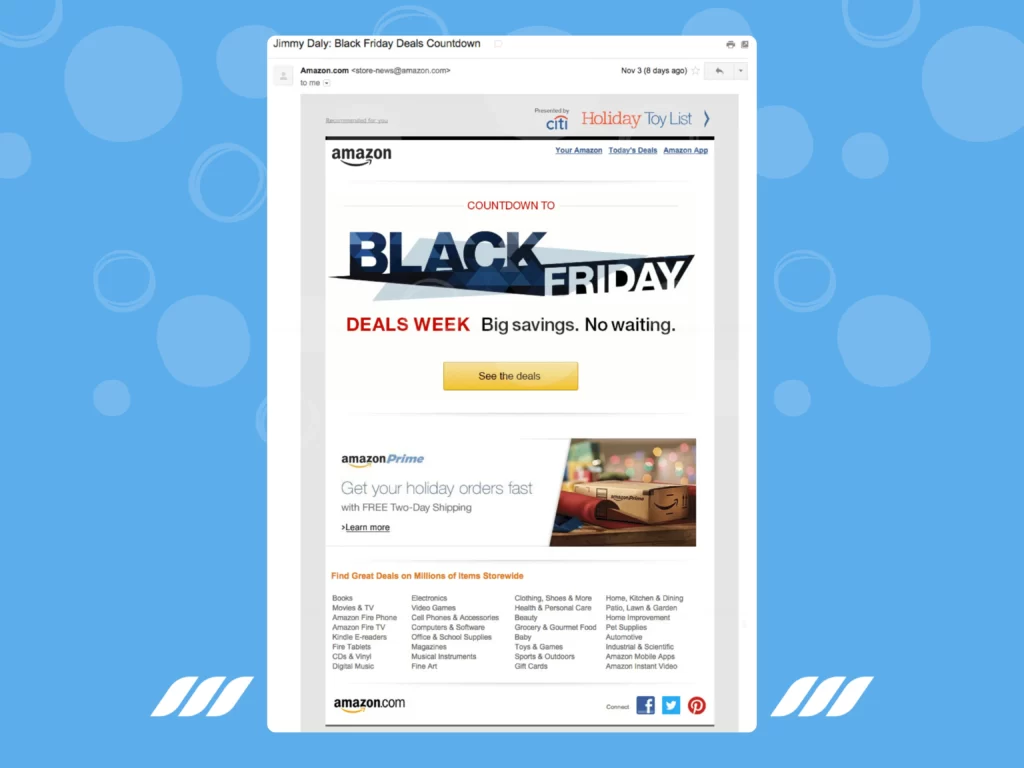

3. Transactional Emails
Transactional emails are very common in e-commerce. These automated messages are the reliable backbone of online shopping, delivering essential information and instilling confidence in customers throughout their buying journey.
Transactional emails are automated messages triggered by specific actions or events, such as order confirmations, shipping notifications, and password resets. In the context of e-commerce, they serve as crucial touchpoints for customers, ensuring a smooth and reassuring shopping experience.
Example: Airbnb
Airbnb is a prime example of a platform that excels in sending transactional emails. When a user books accommodation, they receive a comprehensive booking confirmation email. This email includes essential details, such as the booking dates, accommodation information, and contact details for the host. It not only reassures users about their booking but also enhances their anticipation for their stay.
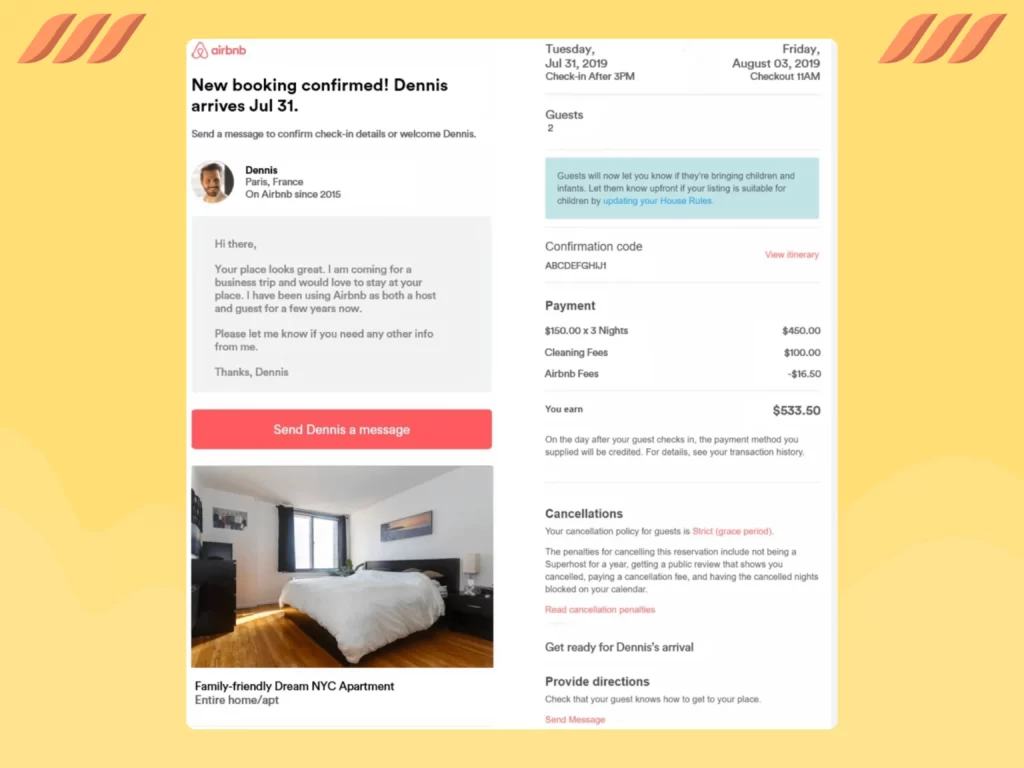

4. Drip Campaigns
Drip campaigns are the nurturing storytellers of the email marketing world. They are carefully crafted automated email sequences designed to engage, educate, and guide subscribers through a carefully curated journey. These campaigns are not about instant sales; instead, they focus on building relationships and trust over time.
These campaigns, also known as automated email series, basically comprise a set of pre-scheduled emails that are sent to your audience in an autopilot mood, depending on their actions, interests, or specific triggers. Drip marketing meaning refers to supply relevant content gradually and strategically, nurturing leads and guiding subscribers toward a desired outcome.
Example: HubSpot’s Email Courses
HubSpot’s email courses serve as an exemplary illustration of drip campaigns in action. These courses offer a sequence of educational emails that empower users to explore various aspects of digital marketing, sales, and customer service. The brand delivers valuable content incrementally, nurturing leads and showcasing its expertise in the field.


5. Personalized Emails
The era of one-size-fits-all marketing is over as more and more brands are adopting the personalized email marketing approach. These emails require a deep understanding and knowledge of your audience’s preferences and using that knowledge to create tailor-made messages that resonate on a personal level.
Personalized emails leverage customer data and insights to deliver content that caters specifically to each recipient’s interests, behaviors, and preferences. These emails aim to create a sense of one-on-one communication, making recipients feel valued and understood.
Example: Spotify
Spotify, the music streaming giant, excels in delivering personalized emails. Their “Discover Weekly” email is a prime example. Every week, subscribers receive a custom-curated playlist based on their listening history and preferences. This personalization not only keeps users engaged but also introduces them to new music they are likely to enjoy.
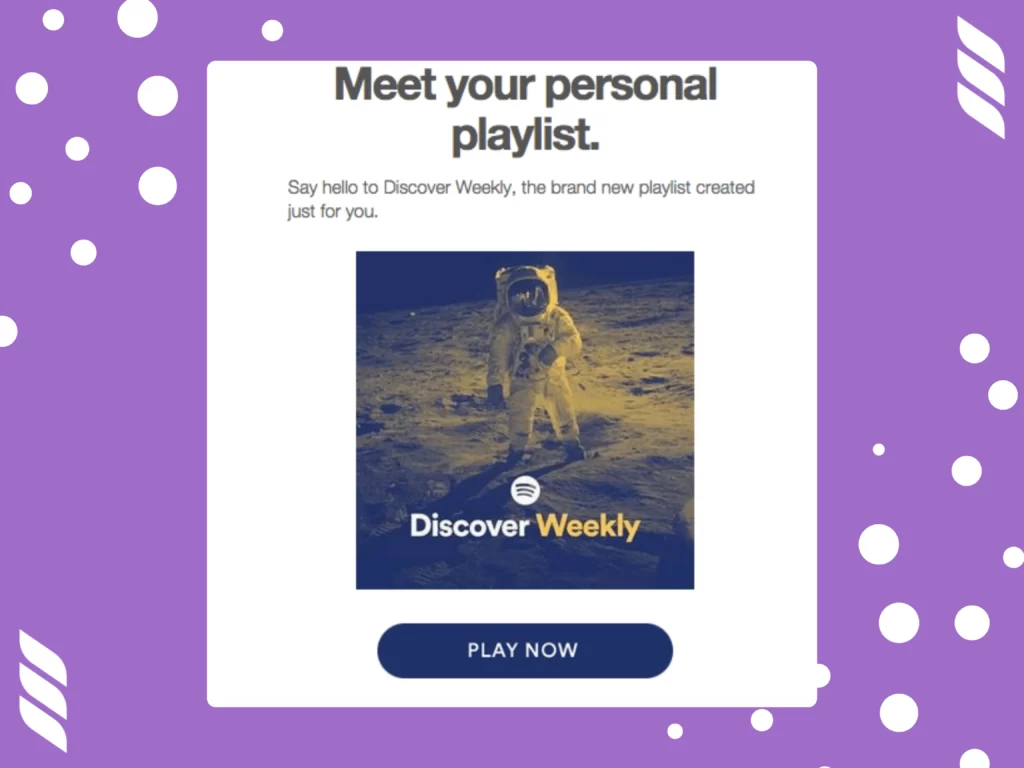

6. Event Invitation Emails
Event invitation emails are the virtual equivalent of rolling out the red carpet. These emails are carefully created to create excitement and anticipation for upcoming events, whether they are webinars, conferences, workshops, or exclusive gatherings.
Event invitation emails are not merely announcements; they are compelling narratives that entice recipients to be part of something special. These emails serve as the first touchpoint in the event journey, aiming to captivate recipients and encourage them to RSVP or register.
Example: Eventbrite
Eventbrite, a platform for event management and ticketing, excels in sending event invitation emails. Their emails are designed to not only inform subscribers about upcoming events but also make it easy for them to register and share the event with their network. Eventbrite’s emails often include vibrant visuals, event highlights, and a straightforward registration process.


7. Abandoned Cart Emails
Abandoned cart emails are the digital equivalent of a courteous salesperson tapping you on the shoulder just as you’re about to leave a physical store without making a purchase.
These automated emails are designed to re-engage customers who have shown interest in your products or services but left items lingering in their online shopping carts. They aim to recover potentially lost sales by reminding customers of their abandoned items and motivating them to complete the purchase.
In other words, abandoned cart emails are automated messages triggered when a customer adds products to their shopping cart but exits the website without completing the purchase. These emails serve as a reminder of the abandoned items. They often include an enticing call to action and sometimes incentives to encourage customers to finalize their orders.
Example: Etsy’s Abandoned Cart Emails
Etsy, a leading online marketplace for unique and handmade products, excels in sending abandoned cart emails. Their emails typically feature high-quality images of the abandoned items, along with a clear call to action to “Complete Purchase.” Sometimes, they even offer a small discount or free shipping to entice customers to finalize their orders.
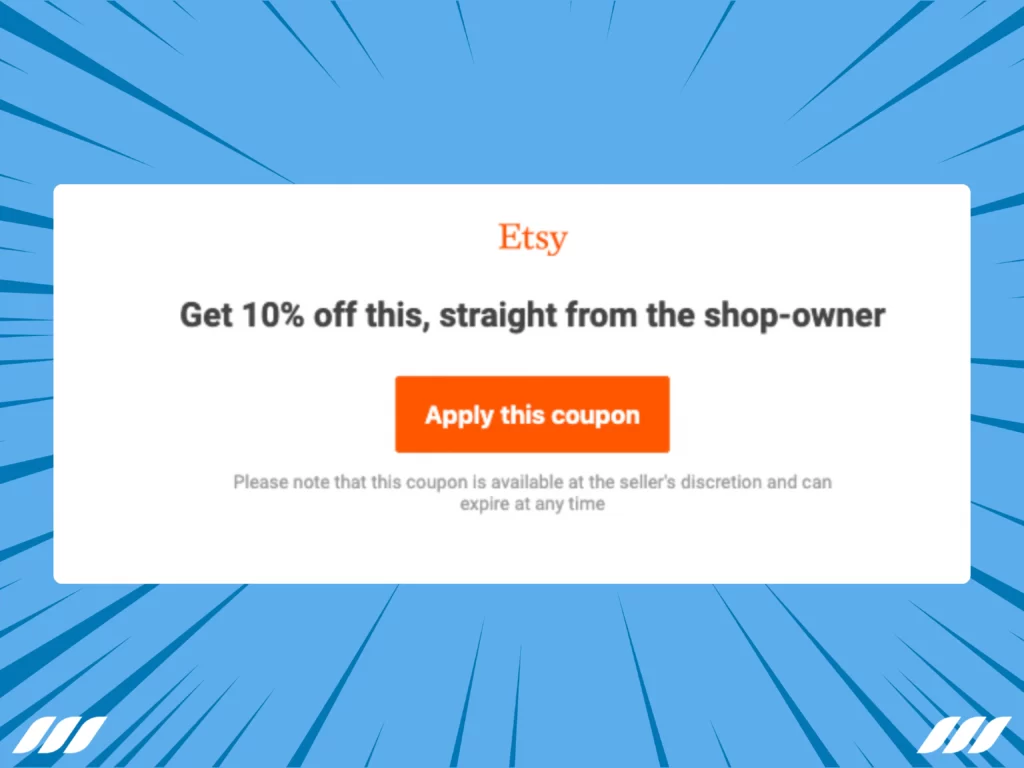

8. Welcome Email
Welcome email is similar to a warm and inviting handshake extended to your new subscribers. These automated email sequences are carefully crafted to introduce your brand, set expectations, and nurture a positive relationship right from the start. A well-designed welcome series can be the key to turning a casual subscriber into a loyal and engaged customer.
These emails are sent immediately after new people sign up for your email list. They serve as the first interaction between your brand and the subscriber, aiming to provide a warm welcome, showcase your value, and encourage engagement.
Example: Birchbox’s Welcome Email
Birchbox, a beauty subscription service, offers an exemplary welcome series that engages and educates new subscribers. Their series includes a warm welcome email, followed by emails that introduce subscribers to their subscription service, highlight the benefits, and provide a glimpse of what they can expect in their upcoming boxes. Birchbox’s welcome series not only sets expectations but also encourages subscribers to explore and engage with their brand.
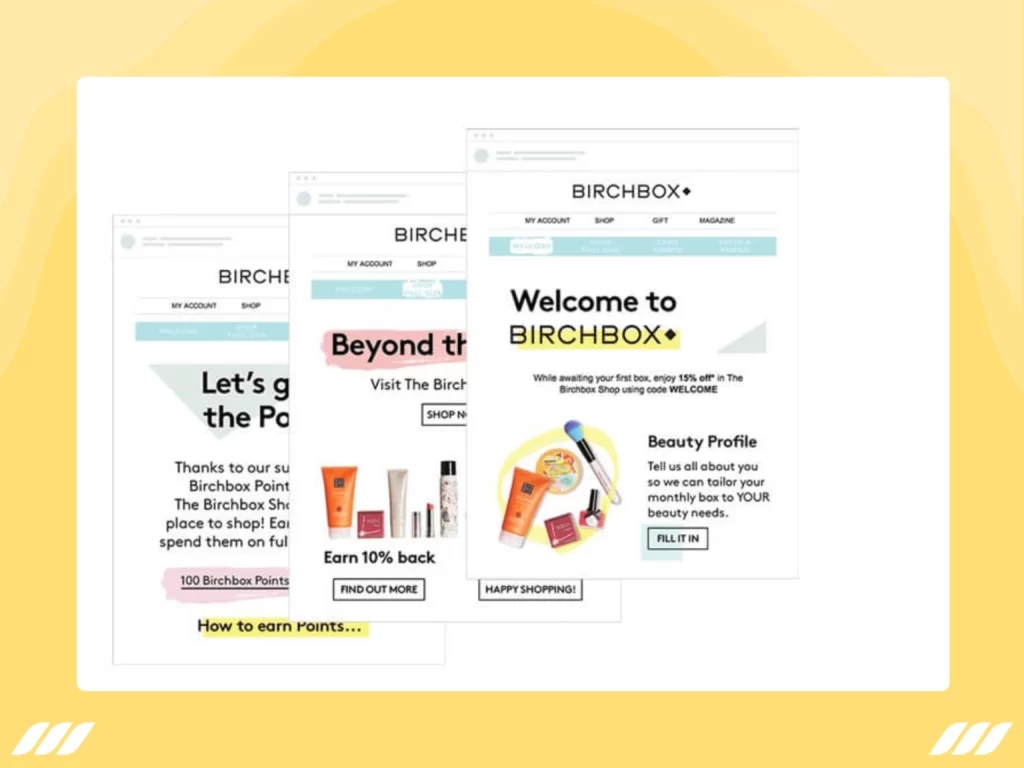

How to Automate Your Email Marketing
Automating your email marketing efforts can significantly streamline your outreach, boost engagement, and save you valuable time. One effective way to do this is by using Dripify sales automation tool.
To get started, you’ll first need to sign up for a Dripify account or a similar email marketing automation tool. Once you’re set-up, follow these steps to automate your email marketing:
- Segment Your Audience: Organize your email list into groups using different factors like demographics, buying history, or how engaged they are with your content. Dripify allows you to create dynamic segments that update in real time, ensuring you always send the right content to the right people.
- Set Up Automated Campaigns: Dripify lets you set up automated email campaigns that will be sent out after a subscriber takes certain actions or in the case of certain events. For example, you can set up a welcome series to send a sequence of emails to greet new subscribers. Or you may set up an abandoned cart email sequence to reconnect with potential customers who left items in their carts.
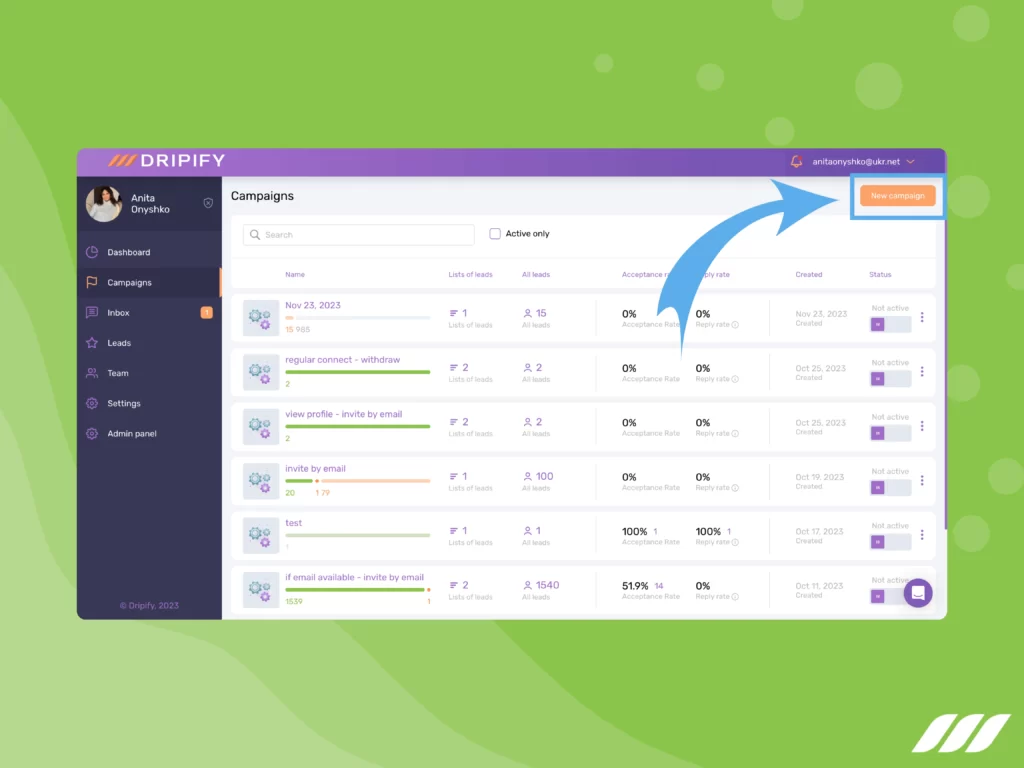

- Personalize Your Emails: Personalization is key to effective email marketing. The good news is that Dripify allows you to personalize emails with dynamic content based on your subscribers’ preferences and behavior. It means your messages can really strike a chord with your audience, leading to a boost in conversion rates.
Using the best email marketing automation tools, you can deliver tailored, timely, and relevant content to your subscribers. This will ultimately increase engagement and drive better results for your business. Automation not only saves you time but also allows you to create a more personalized and effective email marketing strategy.




Conclusion
We explored the definition of email marketing, delved into real-world examples, and uncovered valuable tips to help your email marketing campaigns succeed.
As email marketing evolves with changing consumer preferences and technological advancements, it is vital to stay informed about best practices and industry trends. The tips and examples provided above serve as a valuable guide to help you create effective email campaigns that resonate with your audience.
Don’t forget, it’s about knowing what your audience wants. Keep experimenting, stay in tune with your subscribers, and add a human touch to your emails. With dedication and creativity, email marketing can boost your brand’s success in the digital world.

![How to Write a Price Increase Letter [Tips, Examples, and Free Template]](https://dripify.io/wp-content/uploads/2021/12/27.png)
![How to Write an Effective Collaboration Email [+Templates]](https://dripify.io/wp-content/uploads/2023/05/13.png)



